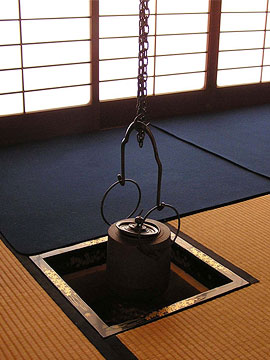A pothook. A device that enables a pot nabe
鍋 or tea kettle tetsubin 鉄瓶 to be suspended over a sunken hearth * irori
囲炉裏. It was called jizaikagi (free hook) because the pothook was
adjustable, allowing a pot to be lowered or raised away from the fire as required.
The most basic type consisted of a piece of rope from which the pot was suspended,
tied to one end of a freely suspended wooden or metal element called *saru
猿. The loose end was passed over a beam, and then threaded through a hole in the
other end of the saru, and knotted to the hook kagi 鈎 which supported the
pot. The drag tension on the rope as it passed through the saru kept the
pot at the desired height; the height could be adjusted and the tension could
be relaxed by changing the angle of the saru. The saru became a
readily recognizable part of domestic architecture as it was often decoratively
designed in the form of a fan or a fish, or the mallet of the god *Daikokuten
大黒天, which was believed to bring prosperity. More sophisticated jizaikagi used
two bamboo or metal poles takesao 竹棹 but they also relied upon the principal
of drag tension and the use of the saru. It is not known when the jizaikagi
was invented but it was already in use in the Muromachi period. It was used in
service buildings, vernacular houses *minka
民家 and tea houses *chashitsu
茶室. It is said to have been introduced into tea houses by Takeno Jouou 武野紹鴎 (1502-55),
inspired by one he had seen in a rural house.
Often abbreviated to jizai
自在, it also had a variety of local names including kagidoko 鈎どこ, Nagano
prefecture; tsurikagi 吊り鈎, Ishikawa prefecture; kagizuru 鈎づる, Gifu
prefecture; and oansama おあん様, Chiba prefecture.
|



